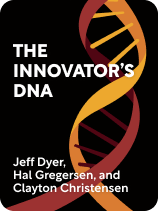

This article is an excerpt from the Shortform book guide to "The Innovator’s DNA" by Jeff Dyer, Hal Gregersen, and Clayton Christensen. Shortform has the world's best summaries and analyses of books you should be reading.
Like this article? Sign up for a free trial here.
What is associative thinking? How can it help you succeed in business and other endeavors?
Innovative businesses change the world. The world’s most innovative business leaders develop their radical and creative ideas by practicing five Discovery Skills. The chief among these skills is associative thinking.
Learn what associative thinking is and how you can develop this world-changing skill.
Associative Thinking
The authors contend that associative thinking is the core of creative thinking. So, what is associative thinking, exactly? It’s drawing connections between seemingly unrelated things (questions, problems, concepts, and so on). Creative innovation rarely entails coming up with a completely novel idea. It’s more often about taking existing ideas and associating them with each other in new ways.
The authors’ research showed that business innovators discover creative ideas by connecting the dots between different industries, disciplines, technologies, and areas of expertise. They explain that the more diverse and expansive your mental library of knowledge is, the greater your chance of associating two ideas that lead to innovation. For this reason, innovative thinkers work to expand their mental libraries by seeking a wide variety of professional and personal experiences, like traveling outside their home countries and taking classes in unfamiliar subjects that pique their curiosity.
(Shortform note: Having a diverse and broad mental library built from a wide variety of life and educational experiences is referred to by some business experts as being a generalist. They argue that companies seeking a competitive innovation edge should hire generalists over specialists. They explain that generalists are better at making connections across specialties and discovering promising combinations—in essence, they are better at associative thinking, which is crucial for successful innovation.)
To think associatively, you must understand, organize, and store new knowledge and experiences you gain. You can improve these abilities by frequently questioning, observing, networking, and experimenting—the Innovation Skills.
| Associative Thinking Can Form Biases and Stereotypes Your brain’s ability to make associations between concepts and things is a key part of creative thinking. However, it can also lead to what cognitive psychologists call implicit bias—the automatic and unconscious attitudes or beliefs that influence our behavior toward certain groups of people. When encountering a new situation, person, or idea (while in a foreign country or taking a new class, for example), our brains automatically try to associate it with past experiences and knowledge. These associations form our unconscious attitudes or beliefs. If we’re repeatedly exposed to negative portrayals of a particular group in the media, for example, our brains may automatically associate that group with negative traits. This can influence our perceptions, judgments, and behaviors toward them. |
Techniques for Practicing Association Skills
Let your mind wander. Give yourself free time to let your thoughts drift because your brain naturally makes associations when your mind is free to wander. Great philosophers, artists, and scientists throughout history have demonstrated that free time and space help ignite creative ideas.
(Shortform note: In Focus, Daniel Goleman explains that when you let your mind wander, your brain is not actively trying to solve a particular problem or complete a specific task, which allows it to make new associations and connections between seemingly unrelated ideas. Mind-wandering activates brain regions that make up the default mode network, which is involved in associative thinking and facilitates a wide range of other cognitive processes, including memory, socializing, and creativity.)
Challenge your brain to associate. Practice making connections between things that may seem unrelated at first glance. The authors suggest you turn to a random page of a product catalog and ask yourself the following questions: Is the first product I see related to the problem I am trying to solve? If not, can I imagine how it could be?
(Shortform note: Another way to practice associative thinking and boost creativity is to free-write—a technique where you write continuously for a set period of time without worrying about grammar, punctuation, or spelling. Free writing helps you bypass your inner critic and encourages a free-flowing state of mind where you can connect diverse ideas whose relationship may have eluded you before.)
Exercise: Practice Associative Thinking for Creative Business Insights
Associative thinking is the heart of innovative thinking. The following exercise will help you practice your associative thinking skills and learn how to apply creative insights to real-world business challenges and opportunities.
- Pick a random object from your current surroundings, such as a pencil or a coffee mug. Spend two minutes brainstorming a list of at least ten different associations or connections that come to mind when you think about that object. For example, if you picked a coffee mug, you might think of associations like “coffee, tea, warmth, relaxation, conversation, or morning routine.”
- Next, choose one of the association words you came up with and brainstorm a list of at least five new associations or connections that come to mind when you think about that word. For example, if you chose “conversation” as an association for the coffee mug, you might think of new associations like “communication, sharing, inspiration, or socializing.”
- Now select one of your new associations and try to come up with a real-world example or case study of how that word has been used to create something innovative or successful in business. For example, if you chose “communication” as a new association for the coffee mug, you might research how a company like Slack has used its tools to innovate communication in many work settings.
- Next, identify a problem or opportunity in your company that you could potentially address by applying the real-world association you identified above. For example, if you were inspired by how Slack has innovated communication for many companies, you might think about how to innovate communication and collaboration in your workplace.
- Finally, write down a brief action plan for implementing or experimenting with your idea. This could be as simple as scheduling a brainstorming session with your team to explore new and improved ways of communicating and working together.

———End of Preview———
Like what you just read? Read the rest of the world's best book summary and analysis of Jeff Dyer, Hal Gregersen, and Clayton Christensen's "The Innovator’s DNA" at Shortform.
Here's what you'll find in our full The Innovator’s DNA summary:
- The five key skills that are shared by the world's innovation leaders
- Why innovation in business is so important
- How to sustain innovative organizations and teams long term






